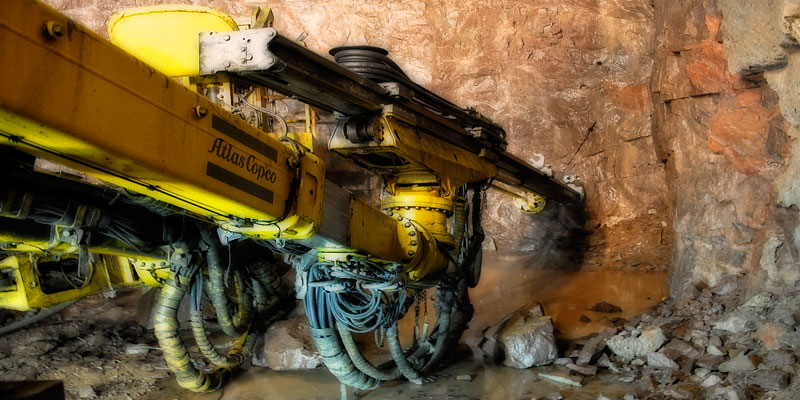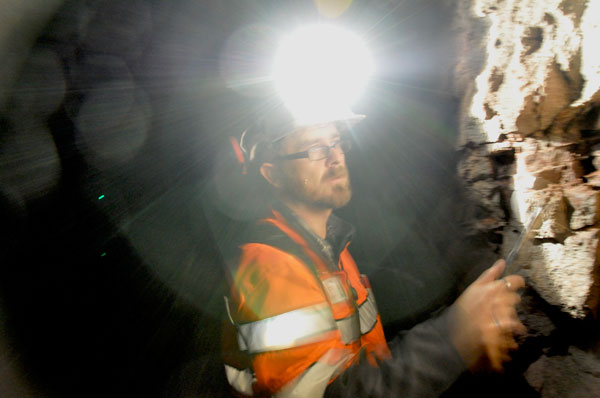The expansion of the Helsinki metro is one of the most extensive ongoing infrastructural projects in Finland. For the planning, boring, and detonating of two 14-kilometre-long parallel tunnels and the construction of eight stations, accurate and extensive planning is required, as well as a constant mapping of the process – work in which geologists have an obvious role to play.
By Marcus Prest
On average, the metro tunnel runs 20-30 metres below the surface. Up to 20 of these metres consist of earth and mud, and beneath the mud lies the bedrock. The engineers have planned the tunnel in such a way as to ensure that there is a consistent layer of some ten metres of rock above the tunnel’s vault.
The geologist Simon Granbacka works for the Finnish engineering company Pöyry. In the recently detonated section of the tunnel that Granbacka is inspecting, there have been reports of ‘spallings’ – blocks of rock falling from the ceiling and sticking out of the walls, ricocheting around in the tunnel, as the pressure is equalling out. In addition, in this particular section of the tunnel there is a large mass of rock that rises 20 metres above the ground, and which causes the pressure levels in the walls of the tunnel to be particularly high. Towards the afternoon the pressure has stabilised and it is safe to move in the tunnels.
It is absolutely pitch dark in the tunnel; there are no sources of light at all except the artificial ones we carry with us. Granbacka has provided us with strong LED-lamps as a complement to the Davy lamps, but if the beam is pointed in the direction of the tunnel the light disappears without lighting up anything at all, except a white rock dust which looks like fine snow or flour, and which makes it necessary to protect the camera lens. It would probably also be a good idea to protect one’s lungs if more time was to be spent down here.
Granbacka leads us down under the earth through the north tunnel in the direction of the working station far to the west. Having walked around for a while, it would be easy for a beginner to get lost, simply not finding the tunnel that leads up to the surface. As I have said, it is absolutely dark and there are no particular indications as to where we are or where to go; the darkness also gives a sense of endlessness, which is not an entirely incorrect notion, considering the extent of the tunnels.
The bed is muddy: it consists of gravel and mud from the crushed rock and is constantly wet due to water, coming either from the boring process, or running down from cracks in the rock. A power cable thickly insulated with rubber also runs through the tunnel – the cable extends from a so-called ‘Jumbo’ boring machine. As we approach, the sound from the drills increases. The boring machine stands on its own at the end of the tunnel, lighting up the rock wall, and the light spreads around the machine forming a cathedral in the dark.
“The reason that the mapping is sometimes so time-consuming is partly the darkness. It takes time to light up the vault metre by metre,” says Granbacka.
Drilling through the bedrock is slow work. Compared to Switzerland or other parts of central Europe, for instance, where the rock is not as compact and you can drill straight through with the help of gigantic boring machines – so called TBMs, Tunnel Boring Machines – the work in Finland is extremely intensive: a number of cavities of a length of six metres each have to be drilled at a time. The cavities are then filled with explosives, the tunnel is evacuated, the explosives are detonated, and the mass of rockfill is transported away. Since work began in 2010, the metro tunnel has advanced 14 kilometres; six metres at a time, and three million cubic metres of rockfill have been transported away.
The detonations done, it is Granbacka’s job to enter the tunnels and map ruptures and the quality of the rock. Occasionally, when the tunnel is ‘unstable’, the job might be a bit dangerous because of the risk of falling rock. Moreover, if the quality of the rock in the newly-cleared space is poor, time is scarce. This is because concrete is sprayed onto vaults and walls to minimise the risk of slides and falling rock, which is a problem, as the concrete conceals the rock and the ruptures that need to be mapped.
On the passage that Granbacka is now inspecting some of the ruptures and crushed zones have already been covered by concrete. The mapping is done manually on a paper sketch pad; sometimes the work is very demanding. Granbacka determines the frequency and character of the ruptures with the help of various parameters; he also checks the direction of the ruptures and their gradients with the help of a compass. The number of ruptures and their character in turn determine the degree to which a given passage must be strengthened by rock bolts and a degree of thickness in the strenghtening concrete. As a rule the Finnish bedrock is very hard and there is thus less need to strengthen it here than in other parts of the world.
My education in geology at Åbo Akademi University has provided me with a fundamental understanding of how the rock behaves, what it consists of, and what one can expect to find in the terrain. The actual planning of the test drilling and the engineering geology I have learnt on the job,” says Granbacka. He received his Master’s degree in geology at Åbo Akademi University in 2007.
The western metroline is a gigantic project; just the planning of the tunnels has been divided into ten segments, for which various engineering companies, such as Pöyry, have tendered. In addition, there are the rails, drainage, ventilation, electricity supply, and all the details of the stations, and so on. Pöyry is responsible for the planning of two segments and two stations, Otnäs and Ängskulla. The entire planning process is governed by Västmetro Ab (Westmetro Ltd.), which in its turn is owned by the City of Helsinki, the City of Vantaa, and the State of Finland.
As the work has been divided into so many sections and is done by so many different firms, it is difficult for the various parties to have an overview of the entire process. A great deal of time goes into meetings where people try to coordinate all those activities that a number of companies share with each other, all with different and simultaneous ongoing sub-projects.
Even the test drilling itself is a very extensive job. Before the drawing up of the tunnel is finished, the rock through which it will run must be carefully probed. Granbacka plans the test drilling, which involves not only drilling straight down through the ground where the tunnel has been projected to open out – this being a probe drilling to find out at what depth the surface of the bedrock is situated. The work also consists of making systematic, diagonal, long slices through the area; so-called core drilling, to get a picture of what is to be found on both sides of the planned walls of the tunnel, and what there is above and beneath them. The probe drilling also requires very precise preparations, as one must take care not to drill into electric cables, water pipes, insulated pipes, mountain heat pipes, and all the other infrastructure that might be buried in the ground of a built-up area. Sometimes it becomes particularly awkward doing test drillings which need to be done through basements; awkward both in relation to the owner of the basement and practically, when the machine, which is the size of a tractor, is to be fitted into an enclosed space.
There are plans for an extension of the western metroline. The issue of funding has not been decided yet, but the fundamental planning, which takes at least a year, has been finished. Granbacka has been out in the terrain marking places for test drilling and working with the route.
“What I’m primarily looking at is the quality of the rock, the character of the rock, and the direction of the ruptures, suitable places for test drilling, and the general morphology of the area, such as the shapes of the landscape, and so on.”
“The test drillings then indicate how the tunnels should be drawn. Simply adjusting the height or the geometry of the tunnel by a couple of metres will have an impact on the whole project over almost the whole route, as the metro is a rather rigid, inflexible vehicle. One must not make the curves too deep.”
The plan is that the new metroline should be taken into use in 2015. At the moment of writing, 96 per cent of the rock work has been finished – the basic work of fitting out the tunnels has begun. Electricity and ventilation plans are being drawn up, and the basics of fitting out more stations has also begun. The rail is waiting its turn.



